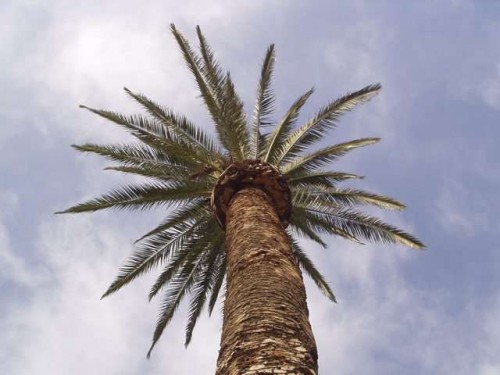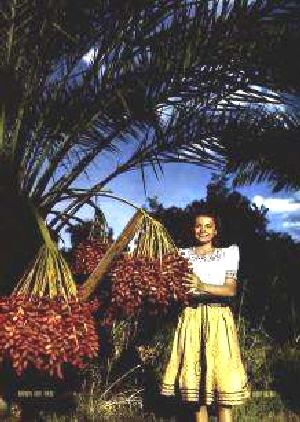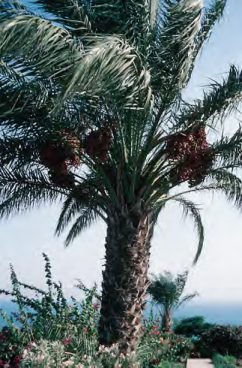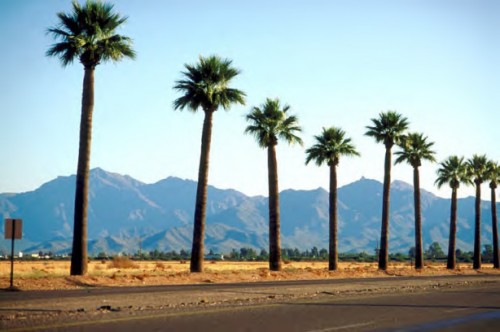|
PALM TREES >> Spiritual Good >> Goods of the Spiritual Church
 The date palm is the one always meant in the Bible; it is the most common and the most useful of the large family of palms. The tree has one single stem which never branches, but rises like a straight, slender column to a great height, and bears at its top a crown of very large and graceful feather-shaped leaves. The old leaves gradually drop off below and new ones grow from the center, keeping the crown always full and green. The flowers are borne in large clusters of many thousands, which hang from among the leaves. The staminate and pistillate flowers are on separate trees, and the Arabs are accustomed to cut the pollen-bearing clusters and tie them in the fertile trees that the fruit may be full and good. The dates are the main dependence of the people in countries where they grow, eaten fresh and preserved in many ways. Other parts of the tree are also useful, especially the large, strong leaves with their tough fiber. The date palm is the one always meant in the Bible; it is the most common and the most useful of the large family of palms. The tree has one single stem which never branches, but rises like a straight, slender column to a great height, and bears at its top a crown of very large and graceful feather-shaped leaves. The old leaves gradually drop off below and new ones grow from the center, keeping the crown always full and green. The flowers are borne in large clusters of many thousands, which hang from among the leaves. The staminate and pistillate flowers are on separate trees, and the Arabs are accustomed to cut the pollen-bearing clusters and tie them in the fertile trees that the fruit may be full and good. The dates are the main dependence of the people in countries where they grow, eaten fresh and preserved in many ways. Other parts of the tree are also useful, especially the large, strong leaves with their tough fiber.
The palm is remarkable for growing in the deserts. It seems to enjoy the greatest heat if only there is water for its roots. It fringes the banks of the Nile under the scorching Nubian sun; it clusters in the hollows of the Sahara where moisture makes oases in the desert; in the old time it was abundant in the hot Jordan valley, causing Jericho to be called "the city of palm-trees." Tadmor or Palmyra, the famous city of the Syrian desert, has its names from this tree of the wilderness.
The remarkable shape of the palm gives us a hint of the kind of knowledge to which it corresponds. The low, wide-spreading branches of the fig seemed appropriate to a knowledge of natural kindness which reaches out on every side in lowly uses. But the palm has no branches, and its tall stem points straight up towards heaven. The knowledge to which it corresponds must relate to one single exalted theme, and the one supreme subject of knowledge is the Lord.
A second help we find in the fact that the palm is the tree of the desert. There are deserts in our lives, and what kind of states are they? Barren states, when there is little that makes life happy. The children of Israel journeyed through the wilderness between Egypt and Canaan, representing the states of privation and trial when we are giving up natural and evil pleasures and have not yet learned the blessedness of a heavenly life. The Lord was led into the wilderness to be tempted of the devil, the wilderness representing the state of conflict and distress before good had gained possession and become fruitful in His life. The burning heat of the desert pictures the heat of selfish passions in these times of trial, causing a feverish thirst for the cool, refreshing knowledge of what it is right and wise to do. Suppose in this desert of excitement and temptation something of the Lord's plain truth, like the commandments, comes home to us, cooling our excitement, quieting our anxious fears, making the way seem plain. It comes as a refreshing stream. Does there not then spring up in the heart a knowledge of the Lord as strong, as lofty, as glorious as any which may grow in happier days? We know Him as our Savior and King; we begin to know the power of His truth to defend us in temptation. Straight upward to the Lord the thoughts rise, grateful, triumphant, resolved to bring forth fruits which shall be living witnesses of His saving power. This knowledge of the Lord as our Savior is the palm of the desert; its leaves are the perceptions and grateful acknowledgments of the power of His truth to save; its fruits are the good works done in that strength, giving to ourselves and others substantial evidence of the Divine power. This noble tree is our shelter and our food in the deserts of temptation. (AE 458; AR 367; AC 8369, 7093) "Blessed is the man that trusteth in the LORD, and whose hope the LORD is. For he shall be as a tree planted by the waters, and that spreadeth out her roots by the river, and shall not see when heat cometh, but her leaf shall be green; and shall not be careful in the year of drought, neither shall cease from yielding fruit." (Jer. xvii. 7, 8)
 "The victor's palm," we say; we "yield the palm" to one who excels; and from very ancient days a palm-leaf has been an emblem of victory. The Greek goddess of victory was represented with a palm-leaf in her hand. It is a relic of the ancient perception that the palm-tree corresponds to a knowledge of the truest kind of victory; a knowledge of the power of the Lord's commandments to conquer in spiritual conflict. "The victor's palm," we say; we "yield the palm" to one who excels; and from very ancient days a palm-leaf has been an emblem of victory. The Greek goddess of victory was represented with a palm-leaf in her hand. It is a relic of the ancient perception that the palm-tree corresponds to a knowledge of the truest kind of victory; a knowledge of the power of the Lord's commandments to conquer in spiritual conflict.
Two passages in the Bible make the meaning of the palm very plain. "On the next day much people that were come to the feast, when they heard that Jesus was coming to Jerusalem, took branches of palm-trees, and went forth to meet him, and cried Hosanna: Blessed is the King of Israel that cometh in the name of the Lord." (John xii. 12, 13) "Branches of palm-trees " are the great spreading leaves. The meaning of the palms is explained by the people's cry "Hosanna [save now]: Blessed is the King of Israel that cometh in the name of the Lord." The palms are grateful and joyful acknowledgments of the Lord's saving power; of the power of His commandments to conquer in temptation, and to lead into all that is good. In the Revelation John "beheld, and, lo, a great multitude which no man could number, of all nations, and kindreds, and people, and tongues, stood before the throne, and before the Lamb, clothed with white robes, and palms in their hands; and cried with a loud voice, saying, Salvation to our God which sitteth upon the throne, and unto the Lamb." (Rev. vii. 9, 10) Once more the palms are interpreted by the voices they are joyful acknowledgments of the Lord's saving power. (AE 458; AR 367; AC 8369)
The children of Israel as they journeyed from Egypt, after some days in the desert, "came to Elim, where were twelve springs of water, and threescore and ten palm-trees and they camped there by the waters." (Exod. xv. 27) A state of peace is described after a season of temptation, an oasis in the journey of life, when the Lord's words come with abundant refreshment, and there springs up a grateful sense of the power of His truth to save. (AC 8366-8370; AE 458) At length the desert journey was ended, and the people crossed the Jordan into the promised land. This stream at the entrance of the land, where afterward John baptized and preached repentance, represents the Lord's commandments in their power to cleanse the life from wrong. Crossing the Jordan, is entering the heavenly life by full acceptance of the commandments as the laws of life. Remember that "the people passed over right against Jericho " (Joshua iii. 16) , "the city of palm-trees " (Deut. xxxiv. 3) , which presently fell into their hands. (Joshua vi) This city of palm-trees at the fords of Jordan, in the lowest part of Canaan, the first city of the promised land to come into possession, represents the first heavenly state; the sense of security in the power of the Lord's commandments; and palm-trees are the knowledge and grateful confession appropriate to this state. (AR 367; AE 458)
 For a similar reason palm-trees were carved on the walls and doors of the temple. "He carved all the walls of the house round about with carved figures of cherubim and palm-trees and open flowers, within and without [both the most holy and the holy chambers]. . . . The two doors [the two leaves of the door between the chambers] were of olive-tree; and he carved upon them carvings of cherubim and palm-trees and open flowers, and overlaid them with gold, and spread gold upon the cherubim, and upon the palm-trees. . . . And the two [outer] doors were of fir-tree . . . and he carved thereon cherubim and palm-trees and open flowers: and covered them with gold fitted upon the carved work." (I Kings Vi. 29-35; Ezek. xli. 18 20) The temple was so built that it represents every true dwelling-place of the Lord. (Chapter xli) It represents heaven, and a heavenly state in every heart, much the same as the promised land. The walls and doors of the temple represent the more external things of a heavenly life, which lead to and protect the more interior things; that is, especially, the keeping of the Lord's commandments with a sense of security which they give against all harm. We see the fitness of palm-trees as decoration for the walls and doors; for they represent the joyful perception of the power of the commandments to defend from evil and to lead to good. (AR 367; AE 277, 458; AC 8369) For a similar reason palm-trees were carved on the walls and doors of the temple. "He carved all the walls of the house round about with carved figures of cherubim and palm-trees and open flowers, within and without [both the most holy and the holy chambers]. . . . The two doors [the two leaves of the door between the chambers] were of olive-tree; and he carved upon them carvings of cherubim and palm-trees and open flowers, and overlaid them with gold, and spread gold upon the cherubim, and upon the palm-trees. . . . And the two [outer] doors were of fir-tree . . . and he carved thereon cherubim and palm-trees and open flowers: and covered them with gold fitted upon the carved work." (I Kings Vi. 29-35; Ezek. xli. 18 20) The temple was so built that it represents every true dwelling-place of the Lord. (Chapter xli) It represents heaven, and a heavenly state in every heart, much the same as the promised land. The walls and doors of the temple represent the more external things of a heavenly life, which lead to and protect the more interior things; that is, especially, the keeping of the Lord's commandments with a sense of security which they give against all harm. We see the fitness of palm-trees as decoration for the walls and doors; for they represent the joyful perception of the power of the commandments to defend from evil and to lead to good. (AR 367; AE 277, 458; AC 8369)
"The righteous shall flourish like the palm-tree." (Ps. xcii. 12) Plainly it is a promise that those who try to do right shall have an increasing knowledge of the power of the Lord's commandments to defend from evil and to lead to good. The whole Psalm is a grateful confession of this saving power. (AR 367; AE 458; AC 8369)
Author: WILLIAM WORCESTER 1897
 And seventy palm-trees. That this signifies the goods of truth in like manner, that is, in all abundance, is evident from the signification of "seventy," as being all things in the complex, in like manner as "twelve" (see n. 7973); and from the signification of "palm-trees," as being the goods of the spiritual church, which are the goods of truth; and because by "palm-trees" are signified goods, by them is also signified the affection of good, and the consequent delight, for all delight is from the affection of good. As this was signified by "palm-trees," therefore also palm-trees were employed in holy festivities, as in the feast of tabernacles, according to these words in Moses: And seventy palm-trees. That this signifies the goods of truth in like manner, that is, in all abundance, is evident from the signification of "seventy," as being all things in the complex, in like manner as "twelve" (see n. 7973); and from the signification of "palm-trees," as being the goods of the spiritual church, which are the goods of truth; and because by "palm-trees" are signified goods, by them is also signified the affection of good, and the consequent delight, for all delight is from the affection of good. As this was signified by "palm-trees," therefore also palm-trees were employed in holy festivities, as in the feast of tabernacles, according to these words in Moses:
Ye shall take for you in the first day the fruit of a tree of honor, spathes of palm-trees, and a branch of a dense tree, and willows of the torrent; and ye shall be glad before Jehovah your God seven days (Lev. 23:40);
by "the fruit of a tree of honor," is signified celestial good; by "palm-trees," spiritual good, or the good of truth; by "a branch of a dense tree," the truth of memory-knowledge; and by "willows of the torrent," the lowest truths of the natural; thus by these four are signified all goods and truths in their order.
[2] That "palm-trees" signified a holy festivity which is from good, is evident also from these words in the following passages:
A great crowd that had come to the feast, when they heard that Jesus was coming into Jerusalem, took boughs of palm trees, and went forth to meet Him, and cried out, Hosanna: Blessed is He that cometh in the name of the Lord, even the King of Israel (John 12:12, 13).
I saw, when behold a great crowd standing before the throne, and before the Lamb, clothed in white robes, and palms in their hands (Rev. 9).
The vine hath dried up, and the fig-tree languisheth, the pomegranate, and also the palm-tree, all joy hath dried up from the sons of man (Joel 1:12).
The righteous shall flourish like the palm-tree; he shall grow like a cedar in Lebanon (Ps. 92:12);
here "palm-tree" denotes good; and "cedar" truth.
[3] As a "palm-tree" signifies good, it also signifies wisdom, for wisdom is of good. This was signified by the palm-trees which together with the cherubs and flowers were carved upon the walls of the temple; for "the temple" signified the Lord Himself, and in the representative sense, heaven (n. 2777, 3720). The "cherubs," the "palm-trees," and the "flowers upon the walls" signified Providence, wisdom, and intelligence, which are from the Lord, thus all things which are of heaven. That these were carved on the walls of the temple, is evident in the first book of Kings:
Solomon carved all the walls of the house round about with openings of carvings of cherubs and palm-trees, and openings of flowers; and upon the two doors of woods of oil he carved carvings of cherubs and of palm-trees, and of openings of flowers, and overlaid them with gold, so that he overspread the gold upon the cherubs, and upon the palm-trees (6:29, 32); by these carvings was represented the state of heaven; by the "cherubs," the Providence of the Lord, thus that from Him are all things (that cherubs denote Providence, see n. 308); by "palm-trees," wisdom, which is of good from the Lord; and by "flowers," intelligence, which is of truth from Him; by the "gold" with which the cherubs and palm-trees were overlaid, was signified the good of love which reigns universally in the heavens. (That "gold" denotes the good of love, see n. 113, 1551, 1552, 5658.) Therefore also where the new temple is treated of in Ezekiel, by which is signified the heaven of the Lord, it is said that cherubs and palm-trees were upon the walls everywhere (41:17, 18, 20, 25, 26).[AC8369]
Verse 27. And they came to Elim, and there were twelve springs of waters there, and seventy palm trees; and they encamped there by the waters. "And they came to Elim," signifies a state of enlightenment and of affection, thus of consolation after temptation; "and there were twelve springs of waters there," signifies that they had truths there in all abundance; "and seventy palm-trees," signifies the goods of truth in like manner; "and they encamped there by the waters," signifies that after temptation the truths of faith were set in order by means of the good of love. [AC8366]
Author: EMANUEL SWEDENBORG (1688-1772)
|
|